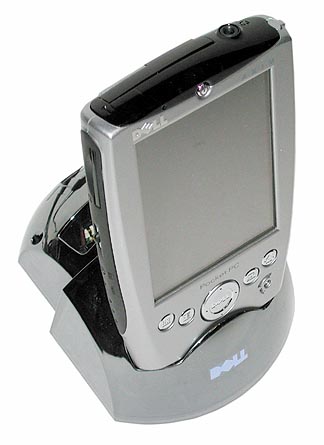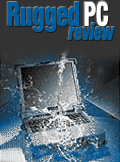Dell Axim X5 Pocket PC
Direct marketing champion Dell enters the Pocket PC arena with a low cost winner
(Pen Computing Magazine, March 2003 issue) --
The only major computer company that has never offered a Windows CE product since the Fall 1996 introduction of Microsoft's mini OS is finally doing so with the Axim line of Pocket PCs. Landing Dell was a big coup for Microsoft which has recently been struggling with attracting (and keeping) big names in its handheld roster. Dell, perhaps the most successful marketer of personal computers and servers in direct sales, has historically given mixed signals about a possible entry into the PDA market. Not enough profit, not enough volume, not enough margin. However, that apparently changed when HP took over Compaq and began marketing itself as a one-stop source of all computing needs. Dell began adding more and more peripherals to its lineup, many carrying the Dell brandname itself. And with HP headed for a virtual monopoly in the Pocket PC market, the addition of a handheld made a lot of sense. Whether or not such a product would add to Dell's bottomline thus became almost irrelevant.
 Those who know the Pocket PC market know that almost all Pocket PCs are made in Taiwan by a small number of skilled companies such as HTC, Mitac, Asus, Acer, Wistron and Compal. HTC, especially, has made a name for itself by providing Compaq with its market-leading iPAQ and also supplied Toshiba with some of its US market Pocket PCs. Asus built Pocket PCs for NEC, Palmax/Compal had made some forays into the PDA market, and Acer/Wistron supplied Casio with the short-lived E-200. According to industry insiders, Wistron then used its considerable expertise in microelectronics to win the Dell contract and thus supply Dell with its first-ever Pocket PC (and handheld computer of any kind). Those who know the Pocket PC market know that almost all Pocket PCs are made in Taiwan by a small number of skilled companies such as HTC, Mitac, Asus, Acer, Wistron and Compal. HTC, especially, has made a name for itself by providing Compaq with its market-leading iPAQ and also supplied Toshiba with some of its US market Pocket PCs. Asus built Pocket PCs for NEC, Palmax/Compal had made some forays into the PDA market, and Acer/Wistron supplied Casio with the short-lived E-200. According to industry insiders, Wistron then used its considerable expertise in microelectronics to win the Dell contract and thus supply Dell with its first-ever Pocket PC (and handheld computer of any kind).
At first sight, there isn't all that much to get excited about the Axim. Unlike some of the recent Palm and Sony PDAs, the Axim sports a somewhat generic, follow-the-leader design that combines commonly expected Pocket PC functionality with design elements pioneered by the iPAQ. The Axim looks and feels pretty hefty, but that perception isn't entirely based on reality. The Axim is, in fact, smaller than the old Casio EM-500 that was once considered tiny and a model of design efficiency, and its footprint is no larger than that of an iPAQ 5400 Series. We're talking 5 x 3.25 inches, a thickness of 0.7 inches, and a weight of 7.2 ounces. The Axim is clearly smaller and lighter than it looks. What gives the Axim its beefy appearance is the relatively small 3.5 inch display sitting in a contemporarily rounded and molded housing with plenty of curves and angles. The Axim is thicker than an iPAQ, but that is primarily because unlike the iPAQ it offers both a Secure Digital AND a Compact Flash slot. The spring-loaded SD slot is on the upper left side and inserting a card will automatically start up the device. The CF slot is on top of the Axim. When it is not occupied by a card, a plastic insert, that's part of the overall plastic top of the Axim, protects the slot. I prefer attached covers as they won't leave a gaping hole if you lose them (and a small piece of plastic will certainly get lost). On the plus-side, the Axim CF card slot can accommodate not only Type I and II cards as the manual implies, but even the thicker Type III cards such as the IBM MicroDrive. In fact, it recognized the MicroDrive without any fuss at all.
Once you get over the visual size of the Axim, you find it to be a very well engineered device. Its rounded design which tapers off towards the bottom fits perfectly into my hand. Black rubber inserts on both sides provide excellent grip. The obligatory control disc flanked by two function buttons below the display works as well as any. The nav disc is complemented by a control rocker on the left side, a design element that harkens back to the early days of the Microsoft palm-size PC. It is on the flimsy side and I am not sure why it is needed. It's also located too fat down the side to be comfortably reached with my thumb. The left side also sports the also obligatory audio recorder button. It is small, recessed into the rubber molding, and you must press it hard for the recorder to come up. A good move as everyone who has filled his or her Pocket PC with dozens of unintended audio files will attest to. On/off is located in the center above the screen and the microphone jack sits on the top right, next to the stylus silo. Having gotten used to the spring-loaded stylus designs of the iPAQ (and my old Newton), coercing the small, flat Axim stylus out of its tight silo with my fingernail felt less than ideal, but it's no big deal. The battery is a rechargeable 5.33 WattHour Li-Ion affair that snaps into the back of the Axim. Given that rechargeables can only be recharged so many times, the recent move back to replaceable power packs is a smart move.
Like most modern Pocket PCs, the Axim sports a transflective color LCD, meaning it does not have the annoying "neon" sidelight and uneven display illumination of earlier reflective displays. The display offers excellent readability both indoors and outdoors. Brightness can be adjusted for indoor and outdoor use, and you can determine how long the backlight will stay on. Even at its brightest setting, the backlight wasn't quite as strong as that on my iPAQ 5400 Series. I've always preferred the larger 3.8-inch display of the iPAQs and wish Dell would have used one instead of the noticeably smaller 3.5 inch screen. As all Pocket PCs, the Axim sports a 240 x 320 resolution that is now exceeded by most of the more advanced Palm OS devices.
Like almost all new Pocket PC designs, the Axim sports an Intel XScale processor. One of the things that differentiates the XScale from its StrongARM predecessor is its dual speed operation that works similar to Intel's "SpeedStep" design in its mobile Pentium processors. While a number of early XScale products either did not make use of this feature or did not provide user control over it, the Axim comes with a control panel that lets you set the processor speed. In the "Normal" setting it runs at 400MHz, in "Power Save" at 200MHz, and there is also an "Auto" mode that turns control over to the device itself. Current Pocket PCs, including the Axim, cannot take full advantage of all of the XScale features (that will require changes to the Pocket PC OS) but having the CPU control panel is a good start.
The Axim comes with 64MB of RAM and 48MB of ROM. With no programs active, the Memory control panel shows total main memory as about 63MB evenly divided between storage and program memory. Of that, almost 60MB is initially available to the user. The Axim has an internal backup utility, so you can backup either the PIM databases or all data onto internal memory or either a CF or SD card. There is no backup scheduling facility to make the process automatic.
While the Axim's design is unexceptional, the same cannot be said of its spectacular dock which seems sculpted from a semi-sphere of smoked mirrored glass. In addition to looking almost impossibly cool, the dock also has a bright blue Dell logo that lights up whenever the unit is inserted, there is room behind the device for the thicker optional 3,400mAH battery (US$129), and there is a separate charging slot for a second battery in the back of the dock. About the only fault we can find with this exceptional design is that it is a bit difficult to insert the Axim into the dock, and once inserted, it doesn't sit very securely. The dock's PC connector cable only has a USB jack--sufficient in this day and age. The power jack can either connect to the dock or directly into the Axim. No extra adapter needed! Also, the Axim's tiny AC adapter won't take up much room, and it plus into the wall not with the brick but with a standard power plug, meaning it will only take one spot on a power strip.
In terms of performance, the Axim matched the iPAQ 5450 in the CPU and memory scores of the VOBenchmark 2.12 tests, but lagged in graphics. This did not seem to matter in day-to-day use of Pocket PC applications.
The Axim's biggest attraction is price. The X5 costs just $349 (and the 32MB, 300MHz X3 version starts at a stunning US$249!) and for that money you get an awful lot of Pocket PC. -
Contact: Dell www.dell.com
|


 Those who know the Pocket PC market know that almost all Pocket PCs are made in Taiwan by a small number of skilled companies such as HTC, Mitac, Asus, Acer, Wistron and Compal. HTC, especially, has made a name for itself by providing Compaq with its market-leading iPAQ and also supplied Toshiba with some of its US market Pocket PCs. Asus built Pocket PCs for NEC, Palmax/Compal had made some forays into the PDA market, and Acer/Wistron supplied Casio with the short-lived E-200. According to industry insiders, Wistron then used its considerable expertise in microelectronics to win the Dell contract and thus supply Dell with its first-ever Pocket PC (and handheld computer of any kind).
Those who know the Pocket PC market know that almost all Pocket PCs are made in Taiwan by a small number of skilled companies such as HTC, Mitac, Asus, Acer, Wistron and Compal. HTC, especially, has made a name for itself by providing Compaq with its market-leading iPAQ and also supplied Toshiba with some of its US market Pocket PCs. Asus built Pocket PCs for NEC, Palmax/Compal had made some forays into the PDA market, and Acer/Wistron supplied Casio with the short-lived E-200. According to industry insiders, Wistron then used its considerable expertise in microelectronics to win the Dell contract and thus supply Dell with its first-ever Pocket PC (and handheld computer of any kind).